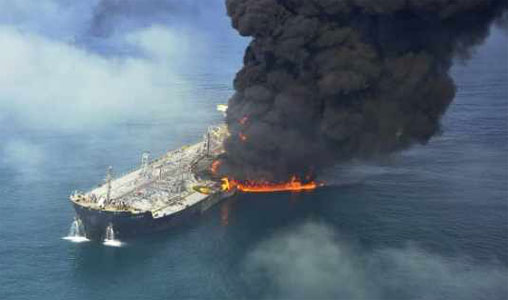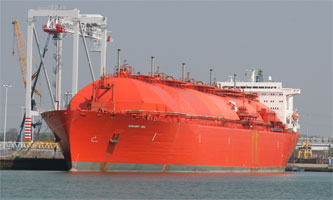In February 2009, « because of the restricted visibility due to foggy conditions » the chemical tanker Kashmir loaded with 30.000 t of oil condensates used by the petrochemical industry collided with the container-ship Sima Saman 13 km off Dubaï. The fire which broke out was only brought under control late at night. The plume of smoke darkened the industrial zone and the port of Jebel Ali, south of Dubaï all day long. Five months later the Kashmir was sold for scrapping and towed to India. Soots, residual liquids, melted materials, released asbestos and PCB, dioxins, the working conditions are particularly dangerous for labourers while breaking up damaged ships.
 Kashmir, February 11th 2009 in Dubaï. The Authorities reported « no marine pollution ».© Reuters/Matthias Seifert
Kashmir, February 11th 2009 in Dubaï. The Authorities reported « no marine pollution ».© Reuters/Matthias Seifert
Inconsistency in the United States
The US MARAD carries on with the destocking of its old troop and cargo carriers and other auxiliary ships. Eight of them have left the Reserve Fleets of James River (Virginia) and Beaumont (Texas). Taking into account the metal market prices and the bad condition of a number of hulls, the dismantling in the United States of these more or less vintage and more or less rusted ships has cost this time the US MARAD between 42 and 96 $ US per ton. However four ships have been sold between 2 and 25 $ US per ton.
The US MARAD shows off honorable and self-governing intentions regarding the scrapping of her old ships (each press release announcing the recycling of an obsolete reserve ship ends up with a notice stressing upon the « environmentally sensitive manner » and « the reycling and disposal of materials in accordance with state and federal law. ») but it seems that some ships are getting away with it.
Two veterans, the Chattahoochee and the Nodaway, respectively 52 and 66 years of age, have been clearly scrapped through another path, exportation. These vintage oil transporters which have been supplying the American Pacific fleet were sold in December 2006 to Teraoka Co Ltd, a Japanese shipbuilding and repair yard. Deflagged from the United States to Mongolia, they were then classified by International Ship Classification, established in Singapore along with the Mongolian, Tuvalu and Kiribati maritime registers. According to the memorandum of Tokyo they are afflicted with 110 and 163 target factors and consequently subjected to « very high risk ». At the end of the game they have been sold to a Japanese scrapping yard.
The fate of two other ships which have been serving the US Navy for 25 years, the PFC James Anderson Jr and the 1st Lt. Alex Bonnyman suggest more queries as to the robustness of the US dismantling process of national ships and the enforcement of the US moratorium on exportation in effect since 1998.
 1st Lt Alex Bonnyman © US Navy
1st Lt Alex Bonnyman © US Navy
These two ships built in Denmark in 1979 and 1980 as Emilie Maersk and Emma Maersk have been operated under long term charters since 1984 by the US Navy, then jumboized and converted in Sparrows Point by Bethlehem Steel. Placed in service under the direction of the Military Sealift Command in the Maritime Prepositioning Ship Squadron at the Diego Garcia Base in the Indian Ocean, they have been carrying equipment to support the United States fleet. These ships are not property of the American Authorities but belong to Wilmington Trust Co. Bank On July 15th 2009, the shipping press annouced that the two ships have been sold for demolition in India; deflagged to Saint-Kitts-and-Nevis and renamed Anders and Bonny. The American environmentalist NGOs asked the EPA (Environment Protection Agency) to prevent the sailing from Norfolk of these two ships suspected to contain asbestos, PCBs and other toxic materials in spite of the reassuring statement of Denmark. The new owner Star Maritime Corp maintains that the two auxiliary ships equipped with an helicopter platform will be assigned to a sugar traffic between Brazil and India. At the end of August, the EPA has « no reason to retain the ships », they say, while Anders has already left Norfolk Harbour heading for Santos (Brazil) according to the official statement. Will she be loaded with sugar bound for India and then be scrapped ?
Meanwhile, the US merchant ships continue to be beached in Asia without too much soul searching from their American owners. The Hari Bhum and the Perla II have just arrived in Alang as for the Global Patriot beached in Bangladesh under her new Mongolian flag, preceded in the same deflagging process by the ex-Overseas Washington and ex-Perseverance (see the bulletins Ship-breaking.com # 6 and #9).
A good intention in the United Kingdom
Simultaneously in Europe, the United Kingdom is launching a frontal attack and is retaining since August, 5th the Margaret Hill planned to be dismantled in India. This LNG Carrier, built in 1974 in Norway, has been laid up in Southampton since November 2008. Though she is flying the Marshall Islands flag, the Margaret Hill is owned by V Ships UK and is on that account according to the European Commission terminology « a ship with a strong link to the European Union ». Therefore the rules prescribed by the European Commission through its Green Paper are likely to be applied to this ship. The British Environment Agency brings up the European regulation forbidding the exportation of toxic wastes towards non OECD countries and emphazises that the permission for this ship to sail will only be given if the dismantling country has the necessary agreements and technical means in place. LNG carriers built in the seventies – like the Margaret Hill – are riddled with asbestos.
 Margaret Hill, April 2009, Southampton © John White
Margaret Hill, April 2009, Southampton © John White
It remains to be seen whether the commercial realities will not be stronger than the best intentions. As a matter of fact, at the same time the general cargo carriers Boularibank, Tikeibank and Gazellebank , the bulk carrier Alinda, the reefer Alcazar Carrier and the container ship Hyundai Admiral, all owned by British companies and likewise the container-ship ANL Explorer flying the Union Jack are to be scrapped in India, Bangladesh or China, all of them being non-OECD countries.
The destocking continues
The crisis continues to weigh on the freight charges. In order to enable their rise, the world ship-owners would plan to get rid of 20 to 25% of the merchant fleet. In the same trend, several members of the ECSA (European Community Ship owners’ Association) propose to destroy 20% of the ships taking the age as criterion.
Concerning the container ships, 59 ships (26%), they constitute the first of the categories sent to breakage. This is the annual stock sale. The average age of container ships for their death sentence is of 26 and a half years. If one adds the 42 general cargo carriers and the 26 bulk carriers, one obtains 55% of the ships to be demolished. Speculation and consequently the use of floating storage became less attractive with the increase of the oil price, thus supporting a return on the market of demolition of tankers, 51 (23% against 14% in the preceding bulletin), that is to say 28% in tonnage due to the sale of five VLCC (Very Large Crude Carrier), all left for Bangladesh.
Among the ships leaving the fleet, 100 (44%) were operating under European flag or had ship-owners of the European Union or the EFTA (European Free Trade Association) including 37 (16%) Greek; 89 (39%) were built in the European Union or in Norway.
Sub-standards ships are departing in priority, but they are not demolished in the countries, in particular European countries, where they were under detention(s): 128 ships (56%) have been previously detained in harbours worldwide with close to 80% for bulk carriers, general cargo carriers and reefers; 44 (19%) were controlled by a non IACS classification society (International Association of Classification Societies).
The age of end of life vessels leaving the waters during the period of June 27th to September 24th, 2009 ranged between 17 years for the container ships Hyundai Admiral and 67 years for the US MARAD rescue ship Escape ; the average age continues to decrease; in 2008 it was 32 years, today it is 29 years, and even less if excluding the American veterans. 54 were less than 150 m, 121 measured between 150 and 199 m and 54 between 200 and up to 324 m in length.
From June 27th to September 24th, 2009, 229 ships departed for demolition. The summer rhythm accelerated again, with an average of 18 ships leaving each week. In number of ships to be demolished as well as in tonnage, India with 95 ships (41%) remains the number 1 destination, ahead of Bangladesh 50 (22%) and China 47 (21%). With 9 ships each, Pakistan marks time but Turkey makes its return. The accumulated demolition will allow the recycling of more than 1.8 million tons of metals. Since the beginning of the year, 686 ships left the world fleet representing 5.8 million tons of metals. The number of ships to be demolished in 2009 will be close to 1,000 units.
Link to the bulletin “Shipbreaking” n°17
 Imprimer cet article
Imprimer cet article









